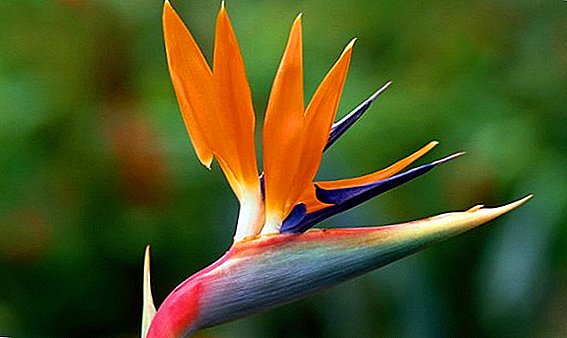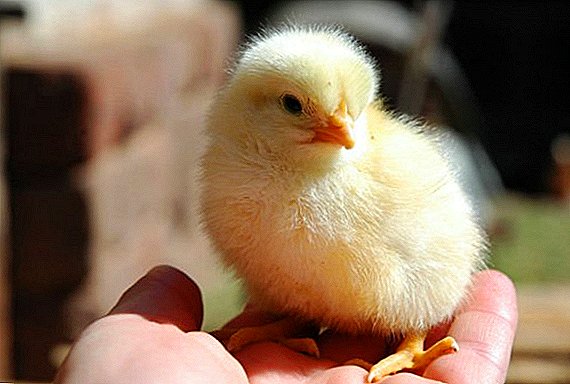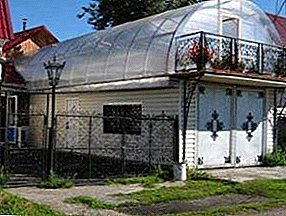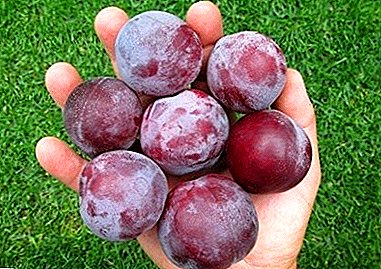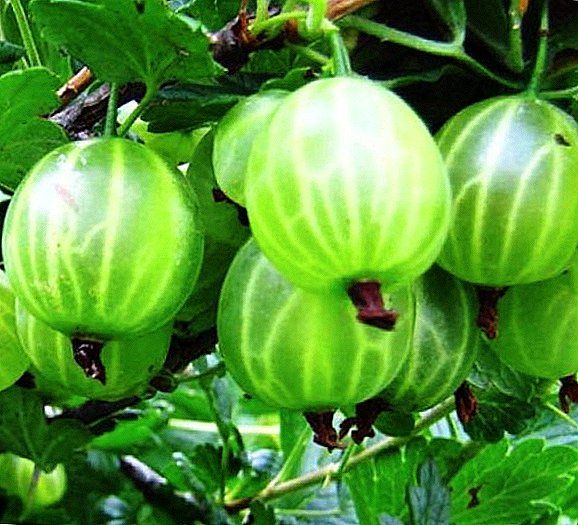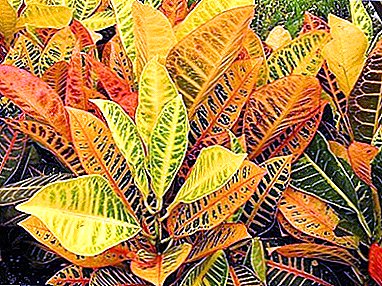
Codiaēum variegātum - multicolor codiame - perennial family euphorbia with large dense painted leaves.
The species’s homeland is the humid tropics India and Malaysia.
Description
Coloring foliage unusually varied: yellow, red, orange, purple, black dots and stripes are combined with lace silver and bronze patterns.
Such magnificence, apparently, was the reason to call this plant "Joseph's Cloak" - by the name of a biblical character who received from his father, to the envy of his brothers, brightly colored clothes of fine manufacture.
Named motley codiaeum and croton. This is the name of the botanists. considered inaccurate.
Like many members of the euphorbia family, the juice that contains codiaum-croton is "Joseph's cloak," poisonous.Therefore the plant Not recommended to grow where there are small children and pets, and after working with him wash your hands well.
When grown in room culture codiaeum does not grow above meter. is he demanding conditions, which should remind his favorite jungle: warm, with bright lighting and high humidity.
However, at home, the codiae "dressed in scarlet and gold" can be not only raised, but also propagated.
Varieties

Motley
Genuin has long rounded leaves, sharpening towards the ends. In the center of the upper side of the sheet is decorated with a thin golden-silver pattern. The leaves are also reddish.
Oval leaf
In accordance with the name, it grows leafy plates rounded to the ends with bright golden-yellow spots on the top of the leaf and near the veins.
Painted
Painted bright yellow and red spots on the green background of elongated, pointed leaves.
Leaflet
This species has wide, rounded leaves that are turned outward at the edges.
Tortoiseshell
The base of the leaf is expanded, by the end it is extended, has a weakly pronounced helicity. The general background of the leaves is green with an olive tinge, the central vein is red, with a longitudinal golden-yellow stripe, and then scattered golden spots. On the same specimen, completely yellow, orange or red leaves can grow simultaneously.
Three-bladed
 Decorated with foliage with carved edges, distantly similar to oak. This species is characterized by golden streaks, stripes and spots.
Decorated with foliage with carved edges, distantly similar to oak. This species is characterized by golden streaks, stripes and spots.
Wrapped
It really wraps its wide, pointed at the ends, leaves inward, towards the stalk, so that the plant becomes spherical.
Forms
Narrow-leaved - leaves centimeter width, somewhat elongated to the top, have a length of 15-20 cm; golden spots are scattered on their verdure.
Predatkovidnaya - the leaves, broad at first, taper off, becoming, as it were, the second petiole for one more leaf of a smaller size. The form is education reminds guitar. Such codeions are motley and green.
Curly Spirale cultivar- leaves are long, narrow, spirally wrapped. They, on a green background, are decorated with spots, stripes, mesh patterns of warm yellow color.
Bladed - with wide, large leaves that have three distinct parts: the central one is much larger than two lateral parts, separated by a noticeable notch. Yellow spots and splashes are scattered on a green background.
Such types of Codiama as Tamara, Excellent, Petra are very popular in home cultivation.
Care
In growing a plant, codiae is variegated; care at home will require the fulfillment of a number of requirements.
Lighting
 All forms and varieties of the "cloak of Joseph" need a bright, mostly diffused, lighting.
All forms and varieties of the "cloak of Joseph" need a bright, mostly diffused, lighting.
Window, facing west or eastconsidered the best for codeii.
On the south windows necessarily shading - otherwise there will be burns, and in the north there will be additional illumination so that the colorful coloring does not disappear.
Temperature
Croton needs a warm habitat, no drafts and abrupt transitions from heat to cold, with a steady annual course of temperature.
Anyway, below 16 degrees temperature should not be lowered.
In cold soil, the plant rots.
The soil
"Joseph's Cloak" feels good in loose, fertile land with a neutral or slightly acid reaction.
From ready-made soil mixtures suitable soils for palm trees and ficus.
You can also mix equal amounts of turf, leaf (or peat) land and washed river sand.
Some more suitable for Croton recipes:
- Garden soil, peat and sand in the ratio of 3: 1: 1;
- Turf ground with small amounts of sphagnum and sand;
- Sod, leaf soil and sand in a ratio of 2: 1: 1.
Before filling the planting container with a soil substrate, in order to prevent water stagnation and root system rotting, a drainage layer of expanded clay, brick fights and pieces of charcoal is poured onto the bottom of the soil.
Transfer
 When transplanting an older plant, the pot is chosen a little, by 2-3 cm, larger in diameter than the former one.
When transplanting an older plant, the pot is chosen a little, by 2-3 cm, larger in diameter than the former one.
Too spacious "apartment" Croton will not like it.
Transplanting croton variegated, try to roll it over, without destroying the earth com.
Frequency of transfers depends on age croton and its growth rate.
With age, the interval between transfers will be 2-3 years or more.
Codiaeum, purchased in the store, is recommended to be transplanted into the "home" tank with a drainage layer and fresh soil mixture, freeing its roots from the transport substrate.
Humidity
Croton is a true child of the tropics and needs year-round high humidity: ideally it should be 70-80%.
Such a plant needs to be sprayed soft water - regularly, daily, especially since he has almost no period of rest.
Useful and monthly shower, and also installation of the container on the pallet with damp pebbles.
Watering
 Water for regular abundant watering "cloak of Joseph" need softwell-settled not cold
Water for regular abundant watering "cloak of Joseph" need softwell-settled not cold
When dosing it is important to observe the principle: "pour, but not pour."
Ideally, the soil does not dry out more than 2 cm, and the water does not stagnate in the pan.
Those flower growers who understand the language of plants well are guided by a barely noticeable lowering of the leaflets of the codiaum: as soon as it happens, watering is needed, and quite generous.
Top dressing
April to August Croton should receive weekly fertilizing with fertilizers for variegated or decorative leafy plants. Good results are also given by the alternation of organic and mineral supplements.
In the autumn-winter period, the frequency of fertilizer application (after watering, on wet soil) decreases to once a month.
Bloom
In summer timeUnder favorable conditions, Crotons can bloom with inconspicuous, shaggy clusters of globs.
Flowering, pollination, ripening of seeds of codiaum is the subject of interest of breeders who breed new varieties of it.
In the usual practice of home flower growing buds are removedso that the codiaeum does not waste energy on the development of colors.
In itself, the intention of the Croton to bloom suggests that the plant is good, it wants to live and reproduce here.
Breeding
 In room culture, codiaeum is propagated vegetatively: cuttings and layering.
In room culture, codiaeum is propagated vegetatively: cuttings and layering.
Reproduction by cuttings:
The best will be apical cuttings 10-15 cm long, no less than with two pairs of leaves, cut with a sharp knife in January-April.
Cut the place sprinkled with crushed charcoal. Milky juice is washed off, the lower section of the cutting is processed by a root formation stimulator and placed in a soil with a temperature of 25-26 degrees.
Cover with plastic wrap, regularly ventilate, moisten the substrate, spray the stalk.
Standard rooting term - a month.
Reproduction by air layouts:
With this breeding method choose a long enough branch, bend it to the surface of the soil, sprinkle it and fix.
After the prikopanny branch takes root and will give new escapes, it is separated from an initial plant.
Diseases and pests
The leaves fade from lack of light: "Joseph's cloak" follows move to a more illuminated placeor light up. Foliage falls from sharp temperature jumps and / or with insufficient air humidity, as well as with insufficient watering.
Foliage falls from sharp temperature jumps and / or with insufficient air humidity, as well as with insufficient watering.
Need to exclude drafts, provide an even temperature background, spray regularly croton with warm soft water, place it on a pallet with wet pebbles, moderately increase watering.
The leaves turn yellow when the soil is wetted and undernourished. Care should be taken to drainage, correct watering and feed codiaum.
The leaves are cracking from excess nitrogen fertilizers.
The leaves of young plants are pale in color - this normal phenomenonwhich passes when the plant gets older.
The leaves are stained, wrinkled - a sign of the presence of gas burning products in the air; you need to move Croton to another room.
The best prevention of diseases of codiam is its maintenance in optimal conditions.
Most dangerous combination of high humidity and low temperatures. In this case, the plant is affected by fungal infections and rots. The increased humidity of the air protects Croton from pest damage.
The increased humidity of the air protects Croton from pest damage.
When kept too dry A mealybug, aphid, scythe or spider mite settles on the plant.
The most effective and fastest way to eliminate pests is use of systemic insecticides.
In the future, the plant must provide the appropriate moisture regime.
Codiaum variegatum requires a level, warm, humid climate, which will require attention and effort to maintain.
It is not surprising that inexperienced florist croton is a plant of one season.
If the "cloak of Joseph" falls into caring hands, it develops over many years and gives rise to a whole grove of magnificent ornamental plants, painted in all shades of early autumn of middle latitudes.


